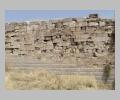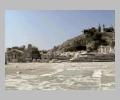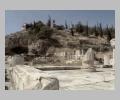
Sacred House. Attica, Eleusis.

Foundation of Arrowhead Tower. Attica, Eleusis.
| Summary: | Panhellenic sanctuary of Demeter and Kore and center for the Eleusinian Mysteries. |
| Type: | Sanctuary |
| Region: | Attica |
Periods:
Middle Bronze Age
Late Bronze Age
Dark Age
Geometric
Archaic
Classical
Hellenistic
Roman
Physical:
The city of Eleusis (birthplace of Aeschylus) is located 22 km W of Athens on a ridge above the bay of Eleusis and at the S side of a large plain. The site has been occupied since the Early Bronze Age and the acropolis fortified at least as early as the Late Bronze Age. The location commands the land routes from Athens to the Peloponnese and NW Greece.
The sanctuary of Demeter is located within the city walls of Eleusis, occupying the area between the E slope of the acropolis and the E fortification wall, and is isolated from the rest of the city by a separate cross-wall at the NE. Within the sanctuary another cross-wall, breached by the Lesser Propylaia divides the N area of the priests' dwellings and administration buildings from the sacred inner peribolos. The main architectural features of the inner sanctuary are the Kallichoron or sacred well, the cave of Pluto adjacent to a triangular court and the Telesterion of Demeter (an almost square building that could seat 3000) where the secret initiation rites were completed and entrance to the uninitiated was forbidden on pain of death. An anaktoron or separate shrine was maintained within the Telesterion. From the outer sanctuary the Greater Propylaia opened onto the grand Sacred Way which joined the sanctuary to Athens.
Description:
According to tradition, Mycenaean Eleusis was the home of an early cult of Demeter and one of the 12 Attic cities to unite in the Synoecism formed by Theseus of Athens. Although the association with Demeter is not definite, remains of a Mycenaean shrine have indeed been found under the later sanctuary of the goddess.
In the Geometric period (at ca. 750 B.C.) the earliest Telesterion (the building where the mysteries were conducted) was built. At ca. 600 B.C. a larger Telesterion, known as the Solonian was built and the Eleusinian Mysteries became a Panhellenic cult.
In the 2nd half of the 6th century B.C., under the influence of Peisistratos and his sons, the size of the sanctuary doubled and new walls and an enlarged Telesterion were constructed. The Peisistratean Telesterion was destroyed during the Persian War. Kimon initiated reconstruction in 470 B.C., but his plans were never completed. The new Telesterion was built during the Periklean age in the 2nd half of the 5th century B.C. and the sanctuary became one of the most renowned in Greece. The fame of the Mysteries spread beyond the Greek borders.
During the Peloponnesian War (431-404) the sanctuary was respected by the warring states. In the 2nd half of the 4th century the sanctuary of Demeter and the city of Eleusis increased in size to attain its greatest extend.
The Roman Emperors favored the sanctuary and the city of Eleusis. When the Kostovoks burned the Telesterion of Perikles in 170 B.C., it was rebuilt and slightly enlarged by Marcus Aurelius. Many Roman officials (including Hadrian in 125 A.D.) were initiated into the Mysteries. The destruction of the sanctuary by the Visigoths in 396 A.D. and the anti-pagan decree of Theodosius ca. 390 A.D. ended religious activity at the sanctuary.
Exploration:
G. Wheler reported on the site in 1676. In 1811 the Dilettanti Society carried out the first excavation. The Greek Archaeological Society has excavated from 1882 to present.
Sources Used:
Other Bibliography:



